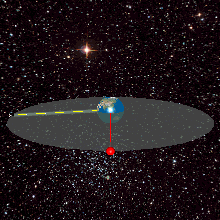Geosynchronous satellite
This article needs additional citations for verification. (January 2008) |

A geosynchronous satellite is a
Geostationary satellites have the unique property of remaining permanently fixed in exactly the
Definition
The term geosynchronous refers to the satellite's orbital period which enables it to be matched, with the rotation of the Earth ("geo-"). Along with this orbital period requirement, to be
If a geosynchronous satellite's orbit is not exactly aligned with the Earth's equator, the orbit is known as an inclined orbit. It will appear (when viewed by someone on the ground) to oscillate daily around a fixed point. As the angle between the orbit and the equator decreases, the magnitude of this oscillation becomes smaller; when the orbit lies entirely over the equator in a circular orbit, the satellite remains stationary relative to the Earth's surface – it is said to be geostationary.
Application
As of October 2018[update], there are approximately 446 active geosynchronous satellites, some of which are not operational.[1][2][3]

Geostationary satellites appear to be fixed over one spot above the equator. Receiving and transmitting
One disadvantage of geostationary satellites is a result of their high altitude:
There are some advantages of geo-stationary satellites:
- Get high temporal resolution data.
- Tracking of the satellite by its earth stations is simplified.
- Satellite always in same position.
A disadvantage of geostationary satellites is the incomplete geographical coverage, since ground stations at higher than roughly 60 degrees latitude have difficulty reliably receiving signals at low elevations. Satellite dishes at such high latitudes would need to be pointed almost directly towards the horizon. The signals would have to pass through the largest amount of atmosphere, and could even be blocked by land topography, vegetation or buildings. In the USSR, a practical solution was developed for this problem with the creation of special Molniya / Orbita inclined path satellite networks with
History
The concept was first proposed by
Widely known as the "father of the geosynchronous satellite",
The first
Westar 1 was America's first domestic and commercially launched geostationary communications satellite, launched by Western Union and NASA on April 13, 1974.
See also
- Geosynchronous orbit
- Geostationary orbit
- Geostationary balloon satellite
- Graveyard orbit
- List of orbits
- List of satellites in geosynchronous orbit
- Molniya orbit
- Tundra orbit
- Polar mount - Mount useful for aiming a satellite dish at geosynchronous satellites
- Satellite television
References
- ^ Christy, Robert. "Geosynchronous Satellites - By Location". Archived from the original on 19 October 2013. Retrieved 18 October 2013.
- ^ "List of satellites in geostationary orbit". www.satsig.net. Retrieved 2018-12-10.
- ^ "CelesTrak: Current NORAD Two-Line Element Sets". www.celestrak.com. Retrieved 2018-12-10.
- ^ "Extra-Terrestrial Relays — Can Rocket Stations Give Worldwide Radio Coverage?" (PDF). Arthur C. Clark. October 1945. Archived from the original (PDF) on 2009-03-18. Retrieved 2009-03-04.
- ^ "Geosynchronous Satellite". Massachusetts Institute of Technology. Archived from the original on 2003-04-17.
External links
- Lyngsat list of communications satellites in geostationary orbit
- For an interactive list of active inactive satellites geosynchronous and orbital at NORAD Celestrack
